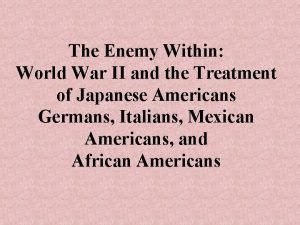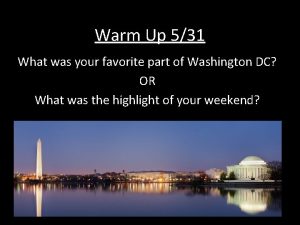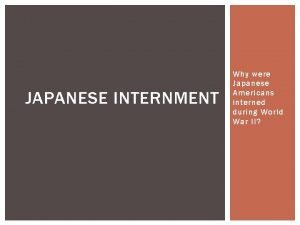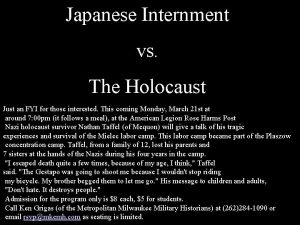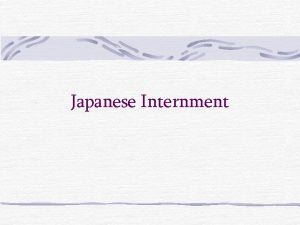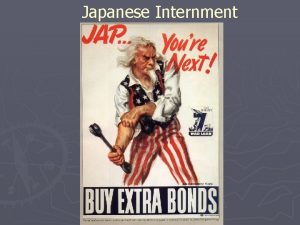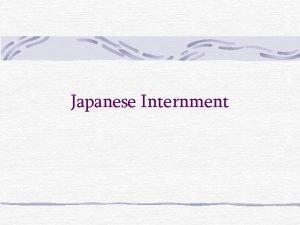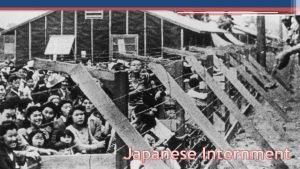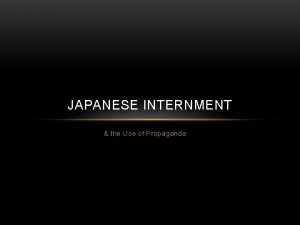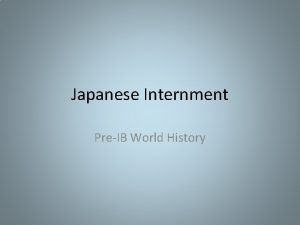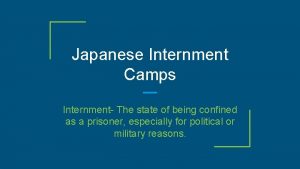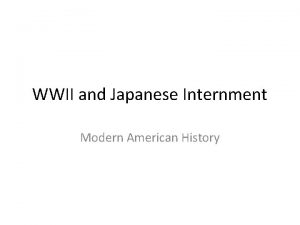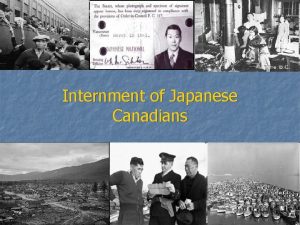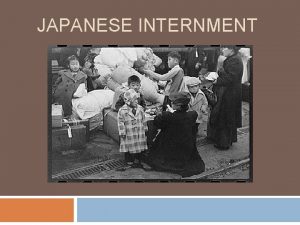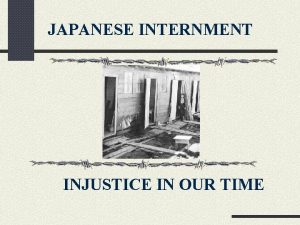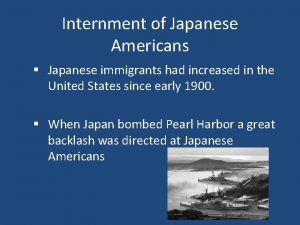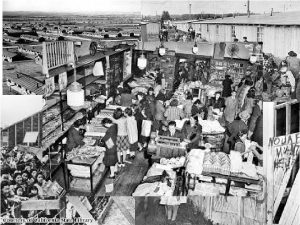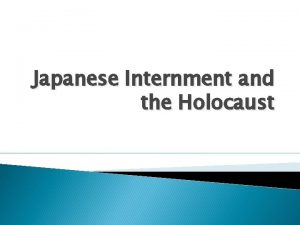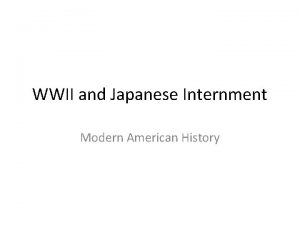Japanese Internment Why were the Japanese and Japanese



















- Slides: 19

Japanese Internment Why were the Japanese and Japanese Americans interned during World War II?

Part #1: Timeline Discuss with your neighbor the following question: Why were the Japanese and Japanese Americans interned during World War II?

Part #2 Munson Report “There is no Japanese ‘problem’ on the Coast. There will be no armed uprising of Japanese. There will undoubtedly be some sabotage financed by Japan and executed largely by imported agents. In each Naval District there about 250 -300 suspects under surveillance. It is easy to get on the list, merely a speech in favor of Japan at some banquet being sufficient to land one there. The Intelligence Services are generous with the title of suspect and are taking no chances. . . There is far more danger from Communists. . . The Japanese here is almost exclusively a farmer, a fisherman, or a small businessman. ” -Munson Report (November, 1941)

Japanese Internment: Discrimination

Anti-Japanese Propaganda DISCUSSION What might be an issue with anti-Japanese propaganda in the United States?

Part #3: U. S. Government Newsreel

Japanese Internment: Santa Anita Race Track

Internment Camp Locations

Japanese Internment

Japanese Internment

Japanese Internment Nisei 2 nd Generation DISCUSSION How might have the younger generation reacted to internment?

Japanese Internment

Japanese Internment 442 nd battalion “Purple Heart Battalion” Helped liberate Italy during World War II

Japanese Internment The Issei 1 st Generation DISCUSSION How might the older generation react to internment?

Japanese Internment

Part # 3: Primary Source Dear Daddy, How are you? We are fine. Thank you for the loose leaf note book. I’m very glad to have it and thank you for the pictures but I don’t like it very much because you look too old and too sleepy, but my mamma said she could make you look younger when we meet together. I’m going to be in third grade Monday September, 14, 1943. Daddy! Don’t get old like the picture you sent. My mother will write soon. Daddy’s girl Tomoko Margery Akahori

Part # 4: Japanese Internment Interviews

Part #5: Korematsu Supreme Court Ruling “We uphold the exclusion order as of the time it was made and when the petitioner violated it. . . In doing so, we are not unmindful of the hardships imposed by it upon a large group of American citizens. . . But hardships are a part of war, and war is an aggregation of hardships. . . All citizens alike, both in and out of uniform, feel the impact of war in greater or lesser measure. Citizenship has its responsibilities, as well as its privileges, and, in time of war, the burden is always heavier. Compulsory exclusion of large groups of citizens from their homes, except under circumstances of direst emergency and peril, is inconsistent with our basic governmental institutions. But, when, under conditions of modern warfare, our shores are threatened by hostile forces, the power to protect must be commensurate with the threatened war” –Korematsu v. the Untied States (1944)

 I am an american japanese internment
I am an american japanese internment Animal haiku
Animal haiku Hey bye bye
Hey bye bye Internment by juliet s kono
Internment by juliet s kono Concentration camps vs internment camps venn diagram
Concentration camps vs internment camps venn diagram How does the newsreel portray internment
How does the newsreel portray internment Concentration camps vs internment camps venn diagram
Concentration camps vs internment camps venn diagram Don't ask why why why
Don't ask why why why Future in the past simple
Future in the past simple Why isn’t kirsti afraid of the soldiers?
Why isn’t kirsti afraid of the soldiers? The tang and song eras were a golden age of
The tang and song eras were a golden age of Hát kết hợp bộ gõ cơ thể
Hát kết hợp bộ gõ cơ thể Ng-html
Ng-html Bổ thể
Bổ thể Tỉ lệ cơ thể trẻ em
Tỉ lệ cơ thể trẻ em Chó sói
Chó sói Chụp tư thế worms-breton
Chụp tư thế worms-breton Alleluia hat len nguoi oi
Alleluia hat len nguoi oi Môn thể thao bắt đầu bằng chữ f
Môn thể thao bắt đầu bằng chữ f Thế nào là hệ số cao nhất
Thế nào là hệ số cao nhất
